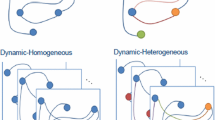Abstract
Graph neural networks (GNNs) have been proved useful for link prediction in online social networks. However, existing GNNs can only adopt shallow architectures as too many layers will lead to over-smoothing and vanishing gradient during training. It causes nodes to have indistinguishable embeddings if locally they have similar structural positions, and this further leads to inaccurate link prediction. In this paper, we propose a unified end-to-end deep learning model, namely Neural Link Prediction (NeuLP), which can integrate the linearity and non-linearity user interactions to overcome the limitation of GNNs. The experimental evaluation demonstrates our model’s significant improvement over several baseline models. Moreover, NeuLP achieves a reliable link prediction given two users’ different types of attributes and it can be applied to other pairwise tasks. We further perform in-depth analyses on the relation between prediction performance and users’ geodesic distance and show that NeuLP still can make accurate link prediction while two users are far apart in the networks.
Access this chapter
Tax calculation will be finalised at checkout
Purchases are for personal use only
Similar content being viewed by others
Notes
- 1.
- 2.
The dataset was collected in 01/2016 when Instagram’s API was publicly available.
- 3.
Code and datasets are available at https://github.com/zhiqiangzhongddu/NeuLP.
References
Backes, M., Humbert, M., Pang, J., Zhang, Y.: walk2friends: inferring social links from mobility profiles. In: CCS, pp. 1943–1957. ACM (2017)
Bhattacharyya, P., Garg, A., Wu, S.F.: Analysis of user keyword similarity in online social networks. Social Network Anal. Min. 1, 143–158 (2011)
Chen, A., Gao, S., Karampelas, P., Alhajj, R., Rokne, J.: Finding hidden links in terrorist networks by checking indirect links of different sub-networks. In: Wiil, U.K. (ed.) Counterterrorism and Open Source Intelligence. LNSN, pp. 143–158. Springer, Vienna (2011). https://doi.org/10.1007/978-3-7091-0388-3_8
Grover, A., Leskovec, J.: node2vec: scalable feature learning for networks. In: KDD, pp. 855–864. ACM (2016)
Hamilton, W.L., Ying, Z., Leskovec, J.: Inductive representation learning on large graphs. In: NIPS, pp. 1025–1035. NIPS (2017)
He, X., Liao, L., Zhang, H., Nie, L., Hu, X., Chua, T.: Neural collaborative filtering, In: WWW. pp. 173–182. ACM (2017)
Jiao, Y., Xiong, Y., Zhang, J., Zhu, Y.: Collective link prediction oriented network embedding with hierarchical graph attention. In: CIKM, pp. 419–428. ACM (2019)
Kingma, D.P., Ba, J.: Adam: a method for stochastic optimization. In: ICLR (2015)
Kipf, T.N., Welling, M.: Semi-supervised classification with graph convolutional networks. In: ICLR (2017)
Lei, C., Ruan, J.: A novel link prediction algorithm for reconstructing protein-protein interaction networks by topological similarity. Bioinformatics 29(3), 355–364 (2012)
Li, G., Müller, M., Qian, G., Delgadillo, I.C., Abualshour, A., Thabet, A.K., Ghanem, B.: DeepGCNs: Making GCNs Go as Deep as CNNs. CoRR (2019). abs/1910.06849
Li, J., Cheng, K., Wu, L., Liu, H.: Streaming link prediction on dynamic attributed networks. In: WSDM, pp. 369–377. ACM (2018)
Li, Q., Han, Z., Wu, X.: Deeper insights into graph convolutional networks for semi-supervised learning. In: AAAI, pp. 3538–3545. AAAI (2018)
Liben-Nowell, D., Kleinberg, J.: The link-prediction problem for social networks. J. Am. Soc. Inf. Sci. Technol. 58(7), 1019–1031 (2007)
Lichtenwalter, R.N., Lussier, J.T., Chawla, N.V.: New perspectives and methods in link prediction. In: SIGKDD, pp. 243–252. ACM (2010)
Liu, X., Murata, T., Kim, K., Kotarasu, C., Zhuang, C.: A general view for network embedding as matrix factorization. In: WSDM, pp. 375–383. ACM (2019)
Menon, A.K., Elkan, C.: Link prediction via matrix factorization. In: Gunopulos, D., Hofmann, T., Malerba, D., Vazirgiannis, M. (eds.) ECML PKDD 2011. LNCS (LNAI), vol. 6912, pp. 437–452. Springer, Heidelberg (2011). https://doi.org/10.1007/978-3-642-23783-6_28
Mikolov, T., Chen, K., Corrado, G., Dean, J.: Efficient estimation of word representations in vector space. In: ICLR (2013)
Mutlu, E.C., Oghaz, T.A.: Review on Graph Feature Learning and Feature Extraction Techniques for Link Prediction. CoRR (2019). abs/1901.03425
Perozzi, B., Al-Rfou, R., Skiena, S.: DeepWalk: online learning of social representations. In: KDD, pp. 701–710. ACM (2014)
Qiu, J., Dong, Y., Ma, H., Li, J., Wang, C., Wang, K., Tang, J.: NetSMF: large-scale network embedding as sparse matrix factorization. In: WWW, pp. 1509–1520. ACM (2019)
Tang, J., Qu, M., Wang, M., Zhang, M., Yan, J., Mei, Q.: LINE: large-scale information network embedding. In: WWW. pp. 1067–1077. ACM (2015)
Velickovic, P., Cucurull, G., Casanova, A., Romero, A., Lio, P., Bengio, Y.: Graph attention networks. In: ICLR (2018)
You, J., Ying, R., Leskovec, J.: Position-aware graph neural networks. In: ICML. JMLR (2019)
Zhang, Y.: Language in our time: an empirical analysis of hashtags. In: WWW, pp. 2378–2389. ACM (2019)
Zhang, Y., Humbert, M., Rahman, T., Li, C.T., Pang, J., Backes, M.: Tagvisor: a privacy advisor for sharing hashtags. In: WWW, pp. 287–296. ACM (2018)
Acknowledgements
This work is partially supported by the Luxembourg National Research Fund through grant PRIDE15/10621687/SPsquared.
Author information
Authors and Affiliations
Corresponding author
Editor information
Editors and Affiliations
Rights and permissions
Copyright information
© 2020 Springer Nature Switzerland AG
About this paper
Cite this paper
Zhong, Z., Zhang, Y., Pang, J. (2020). NeuLP: An End-to-End Deep-Learning Model for Link Prediction. In: Huang, Z., Beek, W., Wang, H., Zhou, R., Zhang, Y. (eds) Web Information Systems Engineering – WISE 2020. WISE 2020. Lecture Notes in Computer Science(), vol 12342. Springer, Cham. https://doi.org/10.1007/978-3-030-62005-9_8
Download citation
DOI: https://doi.org/10.1007/978-3-030-62005-9_8
Published:
Publisher Name: Springer, Cham
Print ISBN: 978-3-030-62004-2
Online ISBN: 978-3-030-62005-9
eBook Packages: Computer ScienceComputer Science (R0)




